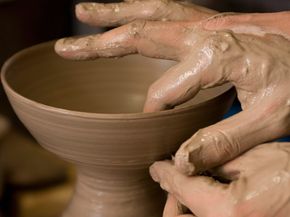Pottery Clay
Anyone who has ever been to summer camp has probably worked with clay. This abundant and naturally occurring resource is the basis of pottery. Pottery clay is mined from the Earth and ground into a powder. This powder is combined with other water and other ingredients to form what's called the clay body -- what you probably picture in your mind when you think of a potter at work. The type of clay, how it's prepared and the amount of water used are all variables in how the final product turns out. There are lots of clays on the market in a wide spectrum of colors depending on your needs and preferences.
Pottery clay needs to be moist, durable and exhibit a good amount of plasticity. This means that it's easy to mold and retains its shape. You can buy a clay body that's ready right out of the box, but many potters prefer to make their own mix specific to a particular piece of pottery. Ingredients like nylon or sand can be added to the clay to aid plasticity, or to lower or raise the clay body's firing temperature, which also affects the color. And because you don't want a 20 pound ashtray, you can add materials like sawdust or coffee grounds to help reduce the weight of the finished piece.
Advertisement
Earthenware clay is most similar to what our ancestors used and is the kind of clay you might find in your backyard or that summer camp craft class. Earthenware pottery pieces are porous, so they need a sealing glaze to make them watertight. These clays require the lowest temperatures for firing, and finished products typically turn out in rich reds, browns and oranges. Terracotta planter pots are a good example of earthenware pottery.
Stoneware clay is more heavy-duty and requires higher firing temperatures. These high temperatures yield a pretty cool result -- the clay vitrifies, or turns into a glass-like substance. An added benefit of vitrification is that it makes the pottery waterproof. This makes glazing stoneware unnecessary, but still an option for decorative purposes. Stoneware clay is typically used for pottery with practical uses like plates, bowls and vases.
Kaolin clay, also called white clay, is used to make porcelain. It goes by many other names as well, including China clay and white cosmetic clay. It has lower plasticity than earthenware and stoneware clays, making it tricky to work with. If you're a beginner, you may want to work your way up to working with white clay. Aside from its uses in the arts and crafts world, Kaolin clay is used in soaps, scrubs and facial masks because it's so mild. These beauty products use Kaolin clay to help reduce swelling and draw impurities from the skin. Next, we'll look at some techniques used in pottery making.
